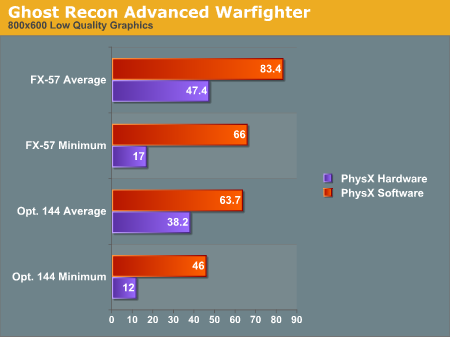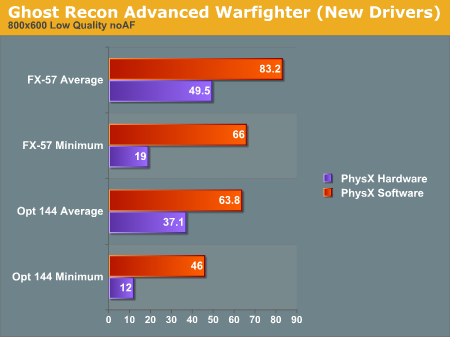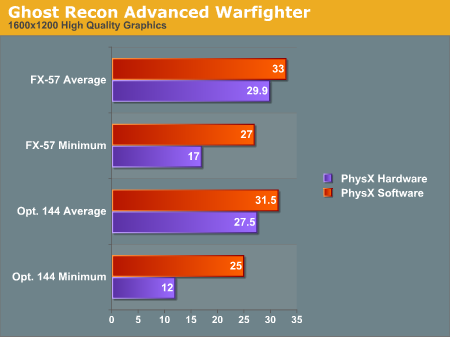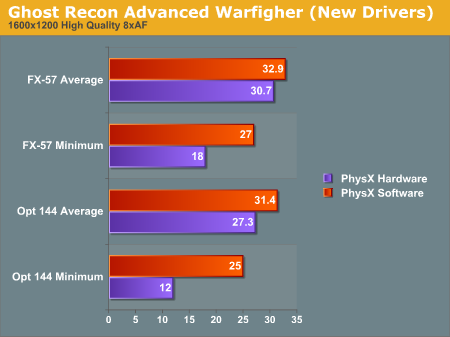Ghost Recon Advanced Warfighter Tests
And the short story is that the patch released by AGEIA when we published our previous story didn't really do much to fix the performance issues. We did see an increase in framerate from our previous tests, but the results are less impressive than we were hoping to see (especially with regard to the extremely low minimum framerate).Here are the results from our initial test, as well as the updated results we collected:




There is a difference, but it isn't huge. We are quite impressed with the fact that AGEIA was able to release a driver so quickly after performance issues were made known, but we would like to see better results than this. Perhaps AGEIA will have another trick up their sleeves in the future as well.
Whatever the case, after further testing, it appears our initial assumptions are proving more and more correct, at least with the current generation of PhysX games. There is a bottleneck in the system somewhere near and dear to the PPU. Whether this bottleneck is in the game code, the AGEIA driver, the PCI bus, or on the PhysX card itself, we just can't say at this point. The fact that a driver release did improve the framerates a little implies that at least some of the bottleneck is in the driver. The implementation in GRAW is quite questionable, and a game update could help to improve performance if this is the case.
Our working theory is that there is a good amount of overhead associated with initiating activity on the PhysX hardware. This idea is backed up by a few observations we have made. Firstly, the slow down occurs right as particle systems or objects are created in the game. After the creation of the PhysX accelerated objects, framerates seem to smooth out. The demos we have which use the PhysX hardware for everything physics related don't seem to suffer the same problem when blowing things up (as we will demonstrate shortly).
We don't know enough at this point about either the implementation of the PhysX hardware or the games that use it to be able to say what would help speed things up. It is quite clear that there is a whole lot of breathing room for developers to use. Both the CellFactor demo (now downloadable) and the UnrealEngine 3 demo Hangar of Doom show this fact quite clearly.










67 Comments
View All Comments
yanyorga - Monday, May 22, 2006 - link
Firstly, I think it's very likely that there is a slowdown due to the increased number of objects that need to be rendered, giving credence to the apples/oranges arguement.However, I think it is possible to test where there are bottlenecks. As someone already suggested, testing in SLI would show whether there is an increased GPU load (to some extent). Also, if you test using a board with a 2nd GPU slot which is only 8x and put only 1 GPU in that slot, you will be left with at least 8x left on the pci bus. You could also experiment with various overclocking options, focusing on the multipliers and bus.
Is there any info anywhere in how to use the PPU for physics or development software that makes use of it?
Chadder007 - Friday, May 26, 2006 - link
That makes wonder why City of Villans was tested with PPU at 1500 Debris objects comparing it to software at 422 Debris objects. Anandtech needs to go back and test WITH a PPU at 422 Debris objects to compare it to the software only mode to see if there is any difference.rADo2 - Saturday, May 20, 2006 - link
Well, people have now pretty hard time justifying spending $300 on a decelerator.I am afraid, however, that Ageia will be more than willing to "slow down a bit" their future software drivers, to show some real-world "benefits" of their decelerator. By adding more features to their SW (by CPU) emulation, they may very well slow it down, so that new reviews will finally bring their HW to the first place.
But these review will still mean nothing, as they compare Ageia SW drivers, made intentionally bad performing, with their HW.
Ageia PhysX is a totally wrong concept, Havok FX can do the same via SSE/SSE2/SSE3, and/or SM 3.0 shaders, it can also use dualcore CPUs. This is the future and the right approach, not additional slow card making big noise.
Ageia approach is just a piece of nonsense and stupid marketing..
Nighteye2 - Saturday, May 20, 2006 - link
Do not take your fears to be facts. I think Ageia's approach is the right one, but it'll need to mature - and to really get used. The concept is good, but execution so far is still a bit lacking.rADo2 - Sunday, May 21, 2006 - link
Well, I think Ageia approach is the worst possible one. If game developers are able to distribute threads between singlecore CPU and PhysX decelerator, they should be able to use dualcore CPUs for just the same, and/or SM3.0 shaders. This is the right approach. With quadcore CPUs, they will be able to use 4 core, within 5-6 yers about 8 cores, etc. PhysX decelerator is a wrong direction, it is useful only for very limited portfolio of calculations, while CPU can do them as well (probably even faster).I definitely do NOT want to see Ageix succeed..
Nighteye2 - Sunday, May 21, 2006 - link
That's wrong. I tested it myself running Cellfactor without PPU on my dual-core PC. Even without the liquid and cloth physics, large explosions with a lot of debree still caused large slowdowns, after which it stayed slow until most of the flying debree stopped moving.On videos I saw of people playing with a PPU, slowdowns also occurred but lasted only a fraction of a second.
Also, the CPU is also needed for AI, and does not have enough memory bandwidth to do proper physics. If you want to get it really detailed, hardware physics on a dedicated PPU is the best way to go.
DigitalFreak - Thursday, May 18, 2006 - link
Don't know how accurate this is, but it might give the AT guys some ideas...http://www.hardforum.com/showthread.php?t=1056037">HardForum
Nighteye2 - Saturday, May 20, 2006 - link
I tried it without the PPU - and there's very notable slowdowns when things explode and lots of crates are moving around. And that's from running 25 FPS without moving objects. I imagine performance hits at higher framerates will be even bigger. At least without PPU.Clauzii - Thursday, May 18, 2006 - link
The German site Hartware.de showed this in their test:Processor Type: AGEIA PhysX
Bus Techonology: 32-bit PCI 3.0 Interface
Memory Interface: 128-bit GDDR3 memory architecture
Memory Capacity: 128 MByte
Memory Bandwidth: 12 GBytes/sec.
Effective Memory Data Rate: 733 MHz
Peak Instruction Bandwidth: 20 Billion Instructions/sec
Sphere-Sphere collision/sec: 530 Million max
Convex-Convex(Complex) collisions/sec.: 533,000 max
If graphics are moved to the card, a 12GB/s memory will be limiting, I think :)
Would be nice to see the PhysiX RAM @ the specced 500MHz, just to see if it has anything to do with that issue..
Clauzii - Thursday, May 18, 2006 - link
Not test - preview, sorry.